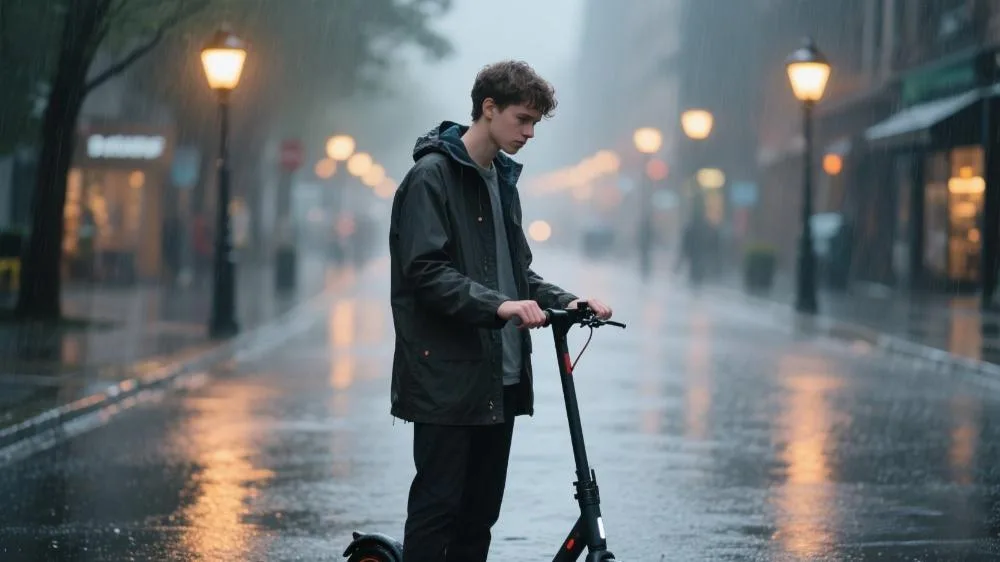can i ride my e-scooter in the rain

Can i ride my e-scooter in the rain? When London finance professional Emma encounters sudden rainfall during her morning commute, she faces a modern urban dilemma: should she continue riding her electric scooter in the rain or seek shelter? According to the 2025 EU Consumer Safety Commission’s “Micromobility Device Weather Resistance Report,” e-scooter safety in wet conditions depends on four critical factors: equipment waterproof ratings, road condition assessment, riding techniques, and emergency preparedness. This guide provides comprehensive rainy-riding solutions based on the latest test data from Germany’s TÜV certification labs and the North American Micromobility Safety Alliance.

Understanding Waterproof Ratings
IP Protection Classifications
2025 Industry Standards:
- Basic Water Resistance (IPX4):
- Resists splashing from all directions
- Maximum exposure: ≤10 minutes
- Example models: Xiaomi Essential 2, Ninebot F2
- Enhanced Water Protection (IPX6):
- Withstands powerful water jets (12.5mm nozzle)
- Maximum exposure: ≤3 minutes
- Example models: Segway GT2, Niu KQi3 Max
- Professional Waterproof (IPX7):
- Temporary immersion (1 meter/30 minutes)
- Fully submersible design
- Example models: Dualtron Storm, Inokim OXO
Key Test Data: 2025 Berlin Technical University lab simulations revealed:
- IPX4 devices showed 27% failure rate after 30-minute rain exposure
- IPX6 devices demonstrated only 3% performance reduction
- Modified scooters had 400% higher water damage risk
Battery and Circuit Protection
Three Critical Safety Elements:
- Sealing Technology:
- Multi-layer silicone gaskets (≥3 layers optimal)
- Automatic drainage valves
- Ultrasonic welding for seams (superior to adhesive)
- Electrical Protection:
- Nano-coated PCBs (anti-corrosion)
- Short-circuit auto-cutoff (response <0.3 seconds)
- Double insulation checks (EN17128 regulation)
- Maintenance Essentials:
- Dry charging ports immediately post-ride
- Weekly seal elasticity inspections
- Avoid direct high-pressure washing
Riding Strategies for Different Rainfall Intensities
Light to Moderate Rain Protocol
Five-Step Safety Process:
- Pre-Ride Inspection:
- Verify tire tread depth (≥3mm)
- Test brake responsiveness (40% longer wet braking distance)
- Check lighting systems (activate if visibility <100m)
- Proper Gear:
- Anti-slip gloves (CE EN13594 certified)
- High-visibility rainwear (≥5cm reflective strips)
- Waterproof shoe covers (non-slip soles)
- Riding Techniques:
- Maintain steady speed (recommended ≤15km/h)
- Brake early (double stopping distance)
- Avoid sharp turns (<15 degree lean angle)
- Route Planning:
- Prioritize roads with drainage systems
- Avoid metal manhole covers/crosswalks
- Use real-time weather apps
- Post-Ride Care:
- Park at 45-degree angle for drainage
- Use compressed air for crevices
- Wait 12 hours before charging
Heavy Storm Response
Danger Recognition System:
- Immediate Stop Conditions:
- Water depth exceeds footrest height (8cm)
- Lightning within 3 kilometers
- Wind gusts >45km/h
- Emergency Procedures:
- Park on elevated ground
- Disconnect battery terminals
- Use full waterproof cover
- Insurance Claims:
- Photograph water level markers
- Obtain official weather reports
- File claims within 72 hours
Regional Risk Considerations
European City Specifics
Comparative Urban Challenges:
| City Characteristic | Primary Risk | Special Protection |
|---|---|---|
| London fog | Low visibility | Install fog lights (2000+ lumens) |
| Amsterdam canals | Slippery surfaces | Off-road tires (5mm tread) |
| Barcelona downpours | Poor drainage | Full-coverage fenders |
| Berlin winter rain | Black ice | Winter tires (3C certified) |
2025 Accident Statistics:
- 230% higher accident rate in rain
- 78% of rain accidents occur at dusk
- Sidewalk riding fines up to €350
North American Considerations
Infrastructure Differences:
- Wide Road Hazards:
- Slow drainage (standing water risk)
- Vehicle splash effect (maintain 3m distance)
- Use median strips as refuge
- Storm Warning Systems:
- NOAA real-time alerts
- Community shelter locations
- On-board emergency kits
- Legal Variations:
- Some states mandate rain speed limits
- Shared scooter rain restrictions
- Insurance deductible adjustments
Emerging Technologies
2025-2026 Waterproof Innovations
Laboratory Breakthroughs:
- Self-Healing Coatings:
- Micro-crack auto-repair (<2 hours)
- BASF polymer technology
- Expected 2026 commercialization
- Hydrophobic Nanomaterials:
- 150°+ contact angle (water beading)
- MIT-validated performance
- Currently in premium models
- Smart Drainage:
- Humidity-activated systems
- Airflow drying technology
- Bosch eBike Systems patent
User Upgrade Recommendations
Three-Step Preparation:
- Purchase Guidance:
- Prioritize modular waterproof designs
- Verify manufacturer warranties
- Authenticate IP certifications
- Skill Development:
- Wet surface balance training
- Emergency braking simulations
- Manufacturer safety workshops
- Community Resources:
- Local riding groups
- Novascooter weather alerts
- Product testing programs
